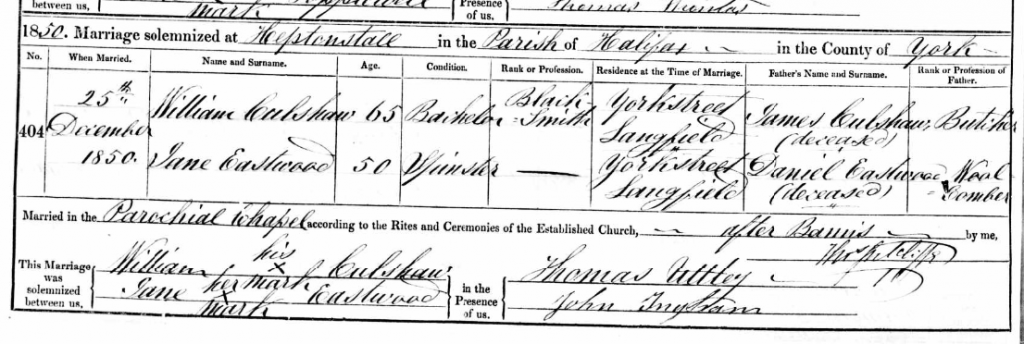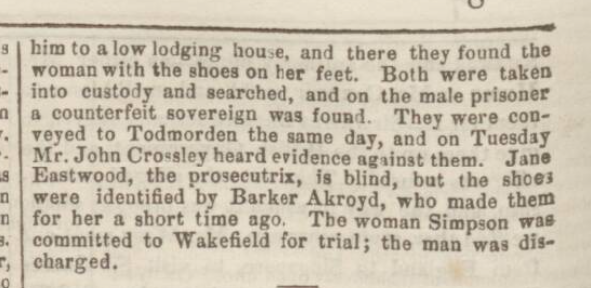Love comes late to some of us, and that’s ok. It’s no less wonderful for that!

William Culshaw, the senior partner, was born around 1785 in Manchester. His father James was a butcher and sadly that’s the end of our knowledge of William’s life. He became a blacksmith and seemingly never married, although this makes the only two William Culshaws on the 1841 Census very confusing. One is a wheelwright, but he’s living a woman named Margaret who’s his age and a younger woman named Ann who is around 25 years old. The 1841 Census doesn’t explain relationships to a head of household so whether she was a wife, or a sister, or sister in law, is unclear. Later on he would claim to have never been married. We’ll have to accept that not all records from that time survived and we can’t always find everything out.
Sixteen years later, in Halifax in 1801, Jane Eastwood was born to woolcomber Daniel Eastwood his wife Betty (Howarth), who had married in 1790 and were living in Chapeltown, at the bottom of Pellon Lane and just as rough and ready then as it is now if not moreso. By 1802 the family had come to Todmorden, to Walsden, but Jane’s baptism is notably absent from any records. Because of this we’re guessing about her parents being Daniel and Betty; they’re the only ones in the right places at the right times to be her parents anyway. Daniel died in 1811 and Betty in 1835, and so the first we see of Jane is her residence on Brook Street, living alone with the abbreviation “Ind” for “independent means next to her name. The following year she appears on tax records as renting a house on York Street, and we learn from a court case in the summer of 1850 that she ran a lodging house on her own.
At some point William moved to Todmorden, the two met (perhaps as lodger and landlady?), and at the not-so-young ages of 65 (William) and 50 (Jane) they were married. The wedding took place at Heptonstall on Christmas Day 1850 – a gift they gave each other.

Jane had a secret, at least a secret to our eyes, which is that she was blind. At what point this began isn’t known but she was undoubtedly so by 1850, because the 1851 Census very plainly states her blindness in the “disability” column at the side. It’s also mentioned in that court case we referred to above. If you already admired Jane as an independent single woman who was paying her own way, admire her doubly now, for doing so with a disability that is not well accommodated now let alone then! It helped that others were willing to give her a hand sometimes though. The Manchester Courier from July 27th 1850 explains:


Barker Ackroyd, local shoemaker and the father of Roger, John, and William – amongst others buried here – made sure that Jane’s stolen shoes were identified. He’s buried at W10.6 in the private area.
William and Jane had nine and a half years together before William’s death in May 1860 at the age of 75. Neither was young when they married even by today’s terms, and in those days 50 and 65 could be respectable ages to reach. What that near decade was like for them is unknown because they seem to have kept themselves to themselves and not had any difficulties or successes that made a newspaper. Jane had given up landladying and the couple lived at Temperance Street next to the Sobriety Hall after 1857, likely because Jane had been a longstanding tenant of the Brook family (as in, Brook Street) who were involved in the Chartist and Temperance movements. William left her an estate valued just under £450, whether it was his money he brought to the marriage or hers that became his is unknown, but never mind that – Jane was set up to not have to worry too much. She lived off the money left to her, and died three days shy of William’s death-anniversary in May 1869. She was 68 years old.